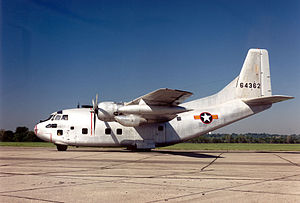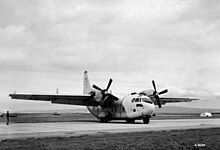Fairchild C-123
| Fairchild C-123 Provider | |
|---|---|
 C-123K with markings of the South Vietnamese Air Force |
|
| Type: | Transport plane |
| Design country: | |
| Manufacturer: | |
| First flight: |
October 14, 1949 |
| Commissioning: |
1955 |
| Production time: |
1954 to 1958 |
| Number of pieces: |
307 |
The Fairchild C-123 Provider is an American transport aircraft manufactured by Fairchild and the successor to the Fairchild C-119 "Flying Boxcar".
General
She was in service with the American Air Force from 1955 and later also with the American Coast Guard . Together with the Grumman HU-16 "Albatross", the aircraft type was the last aircraft of the armed forces of the United States to be powered by radial engines . At the beginning of the 1980s, the last provider was taken out of service. Their only war effort took place in the Vietnam War .
The providers used in Vietnam , Laos and Thailand were designated as C-123K. These machines had additional jet engines , whereby their speed could be increased to 500 km / h. Today the pattern can still be seen in many American museums. The C-123K is also known from films such as Con Air , XxX , Operation Dumbo , Defenseless - The General's Daughter or Air America .
In addition to air transport, one of the main tasks of the C-123 in Vietnam was the spraying of defoliants such as Agent Orange as part of Operation Ranch Hand . A total of around 6,000 missions were carried out from 1962 to 1971, mostly with the Fairchild UC-123B / K.
The NC-123K "Black Spot" version played a little-known role in the blocking of supply routes ( Ho Chi Minh Trail ) during the Vietnam War . Only two pieces were converted, which were then used between 1968 and 1971 at the air force base in Nakhon Phanom with the 606th Special Operations Squadron and the 56th Special Operations Wing.
The NC-123K was equipped with a sensor package that with his performance of AC-130A / E was comparable. For this purpose, the nose was provided with a larger housing to accommodate the sensors. The package included a forward search radar , infrared locator , low- level video display, and laser range finder. This model was also equipped with an advanced navigation system and a computerized weapon drop system for anti-vehicle and anti-personnel bombs. Although both machines were relatively successful, they lacked the operational and survival capabilities of the AC-130 variants. Therefore, her career was short-lived. After intermediate storage in the USA and dismantling to light vans, they were transferred to Thailand.
In addition to the regular war mission, the C-123 was also used on behalf of the CIA for illegal arms transports for the Contras fighting in the Contra war in Nicaragua . This became known after a C-123 was shot down over Nicaragua on October 5, 1986. The arrest of the sole survivor ( Eugene Hasenfus ) played an important role in exposing the Iran-Contra affair .
Today there are at least 40 airworthy copies left as the C-123 is popular with small hauliers. Some of these machines can even be found in warbird circles.
Versions
- XCG-20
- two prototypes of an all-metal cargo glider from the manufacturer Chase Aircraft (later referred to as XG-20 ).
- XC-123
- Equipping an XG-20 with two 2,200 HP Pratt & Whitney R-2800-23 radial engines.
- XC-123A
- Equipping an XG-20 with two General Electric J47-GE-11 jet engines under the wings.
- C-123B
- Production version of the XC-123 with two 2,300 hp R-2800-99W engines. The aircraft could hold 61 fully equipped soldiers or 50 stretchers. Five aircraft were built by Chase and 302 by Fairchild Aircraft.
- HC-123B
- eight C-123B converted to Search and Rescue aircraft for the United States Coast Guard .
- UC-123B
- C-123B converted to spray aircraft.
- VC-123C
- VIP transporter based on the XC-123A was not built.
- YC-123D
- New name for the XC-123A rebuilt by the Stroukoff Aircraft Corporation with a system to influence the boundary layer for better short take-off properties. Here, high pressure air was blown over the top of the wings and control surfaces. The four jet engines were replaced by two Pratt & Whitney R-2800 engines and the vertical stabilizer was built back to the status of the early C-123B built by Chase.
- YC-123E
- a C-123B rebuilt by Stroukoff Aircraft Corporation with modified "Pantobase" fuselage floor, modified wings and tail unit, so that the aircraft can also be used from sand, water, snow and ice.
- YC-123H
- Prototype with widened landing gear and two additional General Electric J85 engines under the outer wings.
- C-123J
- 10 machines each with a Fairchild J44-R-3 jet engine at the wing tips.
- C-123K
- C-123B with larger tires and two additional General Electric J85 engines under the outer wings, 183 were converted.
- NC-123K
- two C-123K converted with night vision devices.
- UC-123K
- 34 C-123K converted to defoliation aircraft ("Ranch Hand").
- VC-123K
- a C-123K converted into a VIP transporter for General William Westmoreland .
- C-123T
- a 1980 Mancro Aircraft Company equipped with Allison T56 -A-7 propeller turbines for the Thai armed forces C-123B. The machine was equipped with fuel tanks in the wings and a power supply unit ( APU ), which supported the control and ensured the heating for the cargo hold. Funding problems forced the Thai government to discontinue the program in 1981.
- Stroukoff YC-134
- a 1956 by Stroukoff Aircraft Corporation converted C-123B with boundary layer exhaust, 3,500 hp (2,600 kW) Wright R-3350-89 radial engines, modified tail unit and landing gear (later referred to as YC-134A). A further development was abandoned in favor of the Lockheed C-130 .
production
Eighteen C-123Bs were built as part of the Mutual Defense Aid Program (MDAP). The XC-123 and 1 C-123B were produced by Chase, the XC-123D by Stroukoff.
Acceptance of the C-123 by the USAF:
| version | 1951 | 1952 | 1953 | 1954 | 1955 | 1956 | 1957 | 1958 | TOTAL |
|---|---|---|---|---|---|---|---|---|---|
| XC-123 | 1 | 1 | |||||||
| C-123B | 2 | 65 | 120 | 84 | 13 | 284 | |||
| C-123B MDAP | 18th | 18th | |||||||
| XC-123D | 1 | 1 | |||||||
| YC-123H | 1 | 1 | |||||||
| TOTAL | 1 | 0 | 0 | 2 | 66 | 120 | 85 | 31 | 305 |
Modifications of the C-123:
| version | 1966 | 1967 | 1968 | 1969 | TOTAL | comment |
|---|---|---|---|---|---|---|
| UC-123B | 15th | 23 | 6th | 44 | from C-123B | |
| C-123K | 104 | 39 | 18th | 161 | from C-123B | |
| VC-123K | 1 | 1 | from VC-123B | |||
| UC-123K | 32 | 13 | 45 | 29 made of C-123K, 16 made of UC-123B | ||
| TOTAL | 15th | 127 | 77 | 32 | 251 |
Furthermore, 10 C-123B were converted into C-123J between July 1, 1957 and June 30, 1958, and a YC-123E was converted from a C-123B between July 1, 1955 and June 30, 1956.
Military users
-
 Brazil
Brazil
-
 El Salvador
El Salvador
-
 Cambodia
Cambodia
-
 Laos
Laos
-
 Philippines
Philippines
-
 South Vietnam
South Vietnam
-
 Saudi Arabia
Saudi Arabia
-
 South Korea
South Korea
-
 Taiwan
Taiwan
-
 Thailand
Thailand
-
 Venezuela
Venezuela
-
 United States
United States
Fairchild NC-123K Black Spot
- Type: multi-seat night supply breaker
-
Drive:
- two Pratt & Whitney R-2800 -99W radial engines with 1,864 kW each
- two General Electric J85-GE-17 turbojets each with 1,293 kg of thrust
- Flight performance: maximum speed 367 km / h; Range 1,665 km
- Dimensions: wingspan 33.53 m; Length 23.24 m
- Mass: empty: nb; Max. Takeoff weight: 27,216 kg
- User: USA
Armament NC-123K
Weapons can be carried at two external load stations with ADU-253 and 272 / B.
- Unguided bombs
- 2 × CBU-2 / A ( cluster bomb with 360 × BLU-3 / B "Pineapple" bombs)
- 2 × CBU-24 / B (cluster bomb in SUU-30B / B bomb cover with 665 bomblets BLU-26 / B)
- 2 × CBU-68 / B (cluster bomb in SUU-30B / B bomb shell with bomblets BLU-48 / B)
Incidents
From the first flight in 1949 to February 2019, the Fairchild C-123 provider suffered 92 total write-offs. 699 people were killed in 51 of them.
Technical specifications
- Crew : 3 (+ up to 62 passengers)
- Span : 33.54 m
- Length: 30.65 m
- Height: 10.94 m
- Performance : two Pratt & Whitney - radial engines with 2,400 horsepower (about 1770 kW)
See also
Web links
Individual evidence
- ^ Northwest Citizen: Where are they now: Eugene Hasenfus
- ^ Al Adcock: C-123 Provider in action , squadron / signal publications, Aircraft Number 124, 1992, p. 22
- ↑ Statistical Digest of the USAF 1951, p. 158; 1952, p. 158; 1953, p. 185; 1954, p. 70; 1955, p. 80; 1956, p. 91; 1957, p. 97; 1958, p. 72
- ↑ Statistical Digest of the USAF 1966–1970, table "Losses and Gains"
- ↑ Accident statistics Fairchild C-123 Provider , Aviation Safety Network (English), accessed on March 9, 2019.




